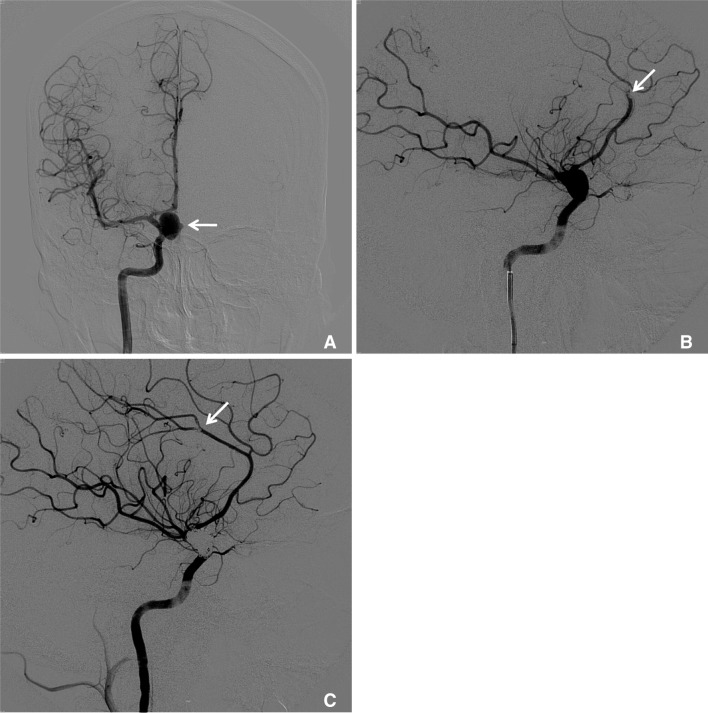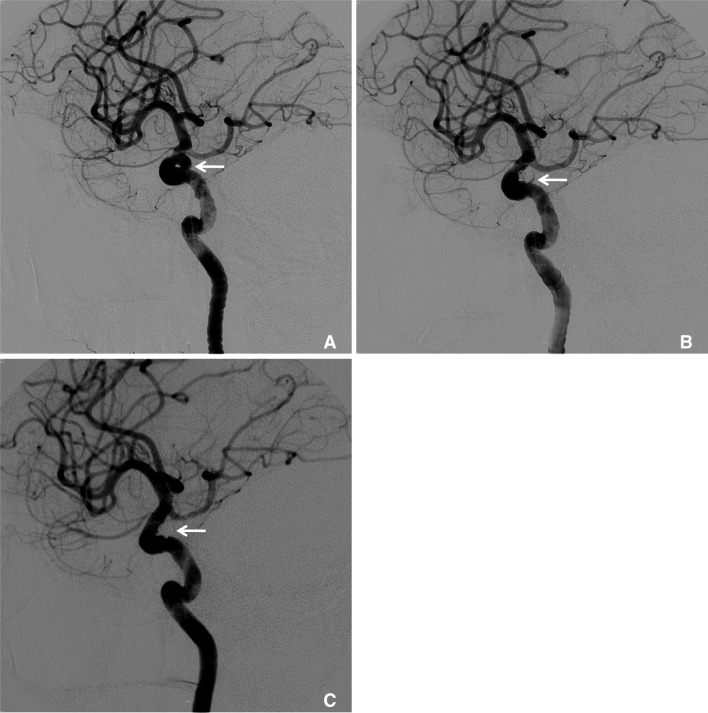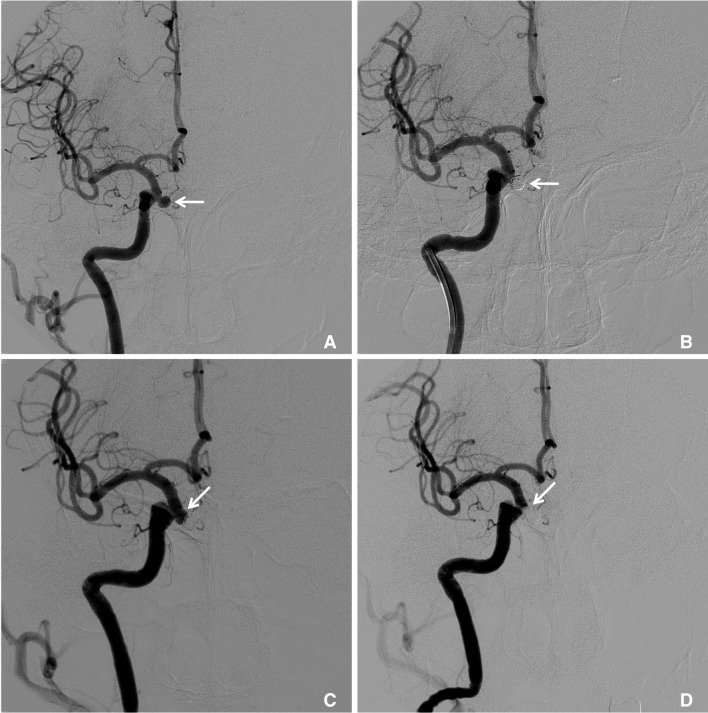Neurointervention.
2014 Sep;9(2):83-88. 10.5469/neuroint.2014.9.2.83.
Angiographic and Clinical Result of Endovascular Treatment in Paraclinoid Aneurysms
- Affiliations
-
- 1Department of Neurosurgery, Good Samsun Hospital, Busan, Korea.
- 2Department of Diagnostic Radiology, Busan Paik Hospital, Inje University, Busan, Korea. hwjeong2000@lycos.co.kr
- 3Department of Neurosurgery, Busan Paik Hospital, Inje University, Busan, Korea.
- 4Department of Neurology, Busan Paik Hospital, Inje University, Busan, Korea.
- KMID: 1910763
- DOI: http://doi.org/10.5469/neuroint.2014.9.2.83
Abstract
- PURPOSE
The purpose of this study was to analyze the results of an immediate and mid-term angiographic and clinical follow-up of endovascular treatment for paraclinoid aneurysms.
MATERIALS AND METHODS
From January 2002 to December 2012, a total of 113 consecutive patients (mean age: 56.2 years) with 116 paraclinoid saccular aneurysms (ruptured or unruptured) were treated with endovascular coiling procedures. Clinical and angiographic outcomes were retrospectively evaluated.
RESULTS
Ninety-three patients (82.3%) were female. The mean size of the aneurysm was 5.5 mm, and 101 aneurysms (87.1%) had a wide neck. Immediate catheter angiography showed complete occlusion in 40 aneurysms (34.5%), remnant sac in 51 (43.9%), and remnant neck in 25 (21.6%). Follow-up angiographic studies were performed on 80 aneurysms (69%) at a mean period of 20.4 months. Compared with immediate angiographic results, follow-up angiograms showed no change in 38 aneurysms, improvement in 37 (Fig. 2), and recanalization in 5. There were 6 procedure-related complications (5.2%), with permanent morbidity in one patient.
CONCLUSION
Out study suggests that properly selected patients with paraclinoid aneurysms can be successfully treated by endovascular means.
Figure
Cited by 1 articles
-
Microcatheter Stabilization Technique Using Partially Inflated Balloon for Coil Embolization of Paraclinoid Aneurysms
Yunsun Song, Boseong Kwon, Abdulrahman Hamad Al-abdulwahhab, Ricky Gusanto Kurniawan, Dae Chul Suh
Neurointervention. 2021;16(2):132-140. doi: 10.5469/neuroint.2021.00185.
Reference
-
1. Wang Y, Li Y, Jiang C, Jiang F, Meng H, Siddiqui AH, et al. Endovascular treatment of paraclinoid aneurysms:142 aneurysms in one centre. J Neurointerv Surg. 2013; 5:552–556. PMID: 23087381.2. Hoh BL, Carter BS, Budzik RF, Putman CM, Ogilvy CS. Results after surgical and endovascular treatment of paraclinoid aneurysms by a combined neurovascular team. Neurosurgery. 2001; 48:78–89. PMID: 11152364.
Article3. Yadla S, Campbell PG, Grobelny B, Jallo J, Gonzalez LF, Rosenwasser RH, et al. Open and endovascular treatment of unruptured carotid-ophthalmic aneurysms: clinical and radiographic outcomes. Neurosurgery. 2011; 68:1434–1443. PMID: 21273934.
Article4. Sun Y, Li Y, Li AM. Endovascular treatment of paraclinoid aneurysms. Interv Neuroradiol. 2011; 17:425–430. PMID: 22192545.
Article5. Park HK, Horowitz M, Jungreis C, Genevro J, Koebbbe C, Levy E, et al. Endovascular treatment of paraclinoid aneurysms: experience with 73 patients. Neurosurgery. 2003; 53:14–23. PMID: 12823869.
Article6. Roy D, Raymond J, Bouthillier A, Bojanowski MW, Moumdjian R, L'Espérance G. Endovascular treatment of ophthalmic segment aneurysms with Guglielmi detachable coils. AJNR Am J Neuroradiol. 1997; 18:1207–1215. PMID: 9282843.
Article7. Day AL. Aneurysms of the ophthalmic segment. A clinical and anatomical analysis. J Neurosurg. 1990; 72:677–691. PMID: 2324793.8. Barami K, Hernandez VS, Diaz FG, Guthiconda M. Paraclinoid Carotid Aneurysms: Surgical Management, Complications, and Outcome Based on a New Classification Scheme. Skull Base. 2003; 13:31–41. PMID: 15912157.
Article9. Jin SC, Kwon do H, Ahn JS, Kwun BD, Song Y, Choi CG. Clinical and radiogical outcomes of endovascular detachable coil embolization in paraclinoid aneurysms : a 10-year experience. J Korean Neurosurg Soc. 2009; 45:5–10. PMID: 19242564.
Article10. Meyer FB, Friedman JA, Nichols DA, et al. Surgical repair of clinoidal segment carotid artery aneurysms unsuitable for endovascular treatment. Neurosurgery. 2001; 48:476–485. PMID: 11270536.
Article11. Ross IB, Dhillon GS. Complications of endovascular treatment of cerebral aneurysms. Surg Neurol. 2005; 64:12–18. PMID: 15993171.
Article12. Park HK, Horowitz M, Jungreis C, Genevro J, Koebbbe C, Levy E, et al. Periprocedural morbidity and mortality associated with endovascular treatment of intracranial aneurysms. AJNR Am J Neuroradiol. 2005; 26:506–514. PMID: 15760857.
- Full Text Links
- Actions
-
Cited
- CITED
-
- Close
- Share
- Similar articles
-
- Frequency and Characteristics of Paraclinoid Aneurysm in Ruptured Cerebral Aneurysms
- Progressive Visual Loss after Endovascular Coiling Treatment of a Large Paraclinoid Aneurysm
- Clinical Outcomes of Endovascular Coil Embolization for Paraclinoid Aneurysms
- The Pterional Approach and Extradural Anterior Clinoidectomy to Clip Paraclinoid Aneurysms
- Clinical and Radiogical Outcomes of Endovascular Detachable Coil Embolization in Paraclinoid Aneurysms : A 10-Year Experience




